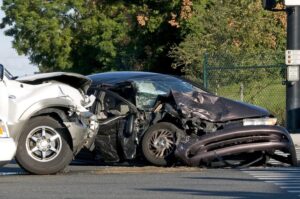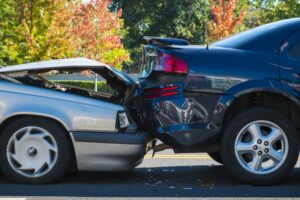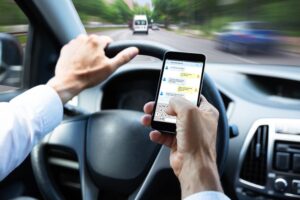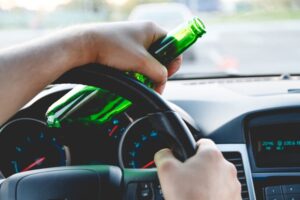Every time you buckle up, you share the road with countless others, and not all of them practice safe driving habits. Here’s what you should know about four of the most common causes of car accidents in Arizona. If you've been involved in an motor vehicle accident, contact a Phoenix car accident Lawyer to discuss your options and protect your rights.
#1 – Failure to Yield the Right of Way
A failure to yield violation occurs when a driver neglects or refuses to yield the right of way to another motorist or pedestrian when the law requires it.
Failing to yield often contributes to car accidents because other road users expect drivers to obey the law and stop or yield. Failure to do so can surprise other road users and increase the likelihood of a collision.
According to the Arizona Department of Transportation (ADOT):
- In one recent year, 21,781 drivers in Arizona committed failure to yield violations that resulted in traffic accidents.
- Failure to yield violations represented 9.35 percent of all driver violations in Arizona traffic accidents that year.
- There were 132 drivers in fatal crashes involving failure to yield violations in 2022. These drivers represented 3.6 percent of all drivers who suffered fatal injuries in accidents that year.
- Failure to yield accidents left 7,828 drivers with injuries that year. These drivers represented 11.07 percent of all drivers who suffered injuries from accidents.
Where and When Do Failure to Yield Accidents Occur?

Here are some common scenarios in which a failure to yield accident might occur:
- At Stop Signs: Side-impact or T-bone accidents can occur if drivers don't yield to the vehicles on their right at four-way intersections.
- At Yield Signs: If drivers disregard a yield sign and don't slow down for crossing traffic, they might collide with vehicles already in the intersection.
- Turning Left: Accidents often happen when drivers turn left fail to yield to oncoming traffic, resulting in front-end or angle collisions.
- In Roundabouts: If a driver entering a roundabout doesn't yield to vehicles already inside the circle, they could cause a side-swipe or angle crash.
- Near Highway On-Ramps: Merging accidents can occur on highways when drivers fail to yield to vehicles already on the main road.
#2 – Speeding
Speeding means driving above the posted speed limit or driving too fast for road, weather, or traffic conditions. Speeding heightens the risk of traffic accidents because it reduces a driver's ability to steer safely around curves or objects, decreases reaction time, and increases stopping distance.
Speeding also makes it difficult to judge other vehicles' speeds and distances, increasing the likelihood of misjudging trajectories and crashing. Furthermore, accidents at higher speeds tend to result in more severe injuries and damage due to the greater force of impact.
ADOT reported the following speed-related crash data for one recent year:
- Last year 34,639 traffic accidents resulted from “speed too fast for conditions” violations in Arizona.
- This violation accounted for 14.86 percent of the total driver violations contributing to statewide traffic accidents that year.
- Of all the drivers in accidents involving “speed too fast for conditions” violations, 183 died, and 11,318 suffered injuries.
- Also that year, 793 Arizona drivers were in traffic accidents resulting from "exceeding lawful speed" violations.
- These violations represented 0.34 percent of the total driver violations contributing to statewide traffic accidents that year.
- Of all the drivers in accidents involving “exceeding lawful speed” violations that year, 66 died, and 346 suffered injuries.
What Accidents Result From Speeding?

Here are some common accidents that can result from exceeding posted speed limits or driving too fast for the conditions:
- Rear-End Collisions: When drivers speed, it compromises their ability to react swiftly to sudden changes in traffic flow or road conditions. This lack of reaction time becomes problematic when other vehicles decelerate or halt, causing the speeding drivers to collide with their rear bumpers.
- Head-on Collisions: Driving at excessive speeds, particularly around curves or bends, decreases a driver's control over their vehicle. Momentum and reduced steering responsiveness can cause vehicles to drift into opposing traffic lanes and collide with others head-on.
- Rollover Accidents: The risk of a vehicle rolling over is more significant at high speeds. Taller vehicles, like SUVs, are especially susceptible due to their higher centers of gravity. When a speeding SUV driver attempts to make a sharp turn or encounters an unexpected obstacle, their vehicle can tip and roll.
- Side-Impact Crashes: Speeding can impair a driver's ability to judge timing and distance at intersections accurately. When a speeding driver doesn't yield or stop at traffic signals, their vehicle can collide with another vehicle moving through the intersection in a side-impact or T-bone collision.
- Chain Reaction Accidents: High speeds can amplify the chaos of any traffic incident. When a speeding driver hits another motorist, the rapid sequence of events can result in a collision involving multiple vehicles and victims.
#3 – Distracted Driving
Distracted driving is driving while engaging in other activities that divert the driver's attention from the road. Common distractions include using cell phones, eating, talking to passengers, or fiddling with entertainment or navigation systems.
Distracted driving can significantly reduce drivers' ability to focus on their surroundings, react to sudden changes or obstacles, and make safe driving decisions. As a result, distracted driving considerably increases the likelihood of traffic accidents.
According to ADOT, 233,053 drivers were in traffic accidents in Arizona last year. Among those drivers:
- There were 200 drivers (0.09 percent) talking on hands-free devices. This type of distraction caused two fatal accidents that year.
- There were 286 drivers (0.12 percent) talking on hand-held devices. This type of distraction also caused two fatal accidents that year.
- There were 595 drivers (0.26 percent) talking to passengers. This type of distraction caused six fatal accidents that year.
- Over 1,000 drivers (0.47 percent) engaged in other activities with electronic devices. This type of distraction caused one fatal accident.
- There were 602 drivers (0.26 percent) manually operating electronic devices. This type of distraction caused four fatal accidents that year.
- About 2,300 drivers (0.97 percent) focused on distractions inside the vehicle, like eating or drinking. This distraction caused eight fatal crashes.
- Over 1,800 drivers (0.77 percent) focused on distractions outside the vehicle. This type of distraction caused nine fatal accidents that year.
What Are the Main Types of Driving Distractions?
Driving distractions jeopardize the safety of drivers, passengers, and others on the road.

Here are the three main types of driving distractions:
- Visual Distractions: These distractions take the driver's eyes off the road. Examples include looking at a GPS device, reading a billboard, or checking a child in the rearview mirror. Even glancing away for a few seconds at highway speeds can result in a driver traveling a significant distance without their full attention on the road.
- Manual Distractions: These distractions involve the driver taking one or both hands off the wheel. Manual distractions include eating, drinking, adjusting the radio, or searching for something in a purse or bag. Without both hands on the wheel, a driver might be unable to react quickly to sudden changes in their surroundings.
- Cognitive Distractions: These distractions divert the driver's mind from driving, even if their eyes are on the road and hands are on the wheel. Daydreaming, thinking about stressful events, or getting engrossed in conversations are all possible cognitive distractions. The danger lies in the driver's reduced ability to recognize and respond to potential hazards or changing conditions.
#4 – Driving Under the Influence
Driving under the influence (DUI) involves operating a motor vehicle with a blood alcohol content (BAC) exceeding the legal limit (0.08 in Arizona).
Consuming alcohol impairs a driver's ability to think clearly, react quickly, and judge distances and speeds accurately. Additionally, alcohol can reduce hand-eye coordination, blur vision, and impair the ability to recognize potential hazards.
As a result, drunk drivers have a higher likelihood of causing traffic accidents. A drunk driver’s slowed cognitive function and impaired judgment put themselves and other road users at risk, making DUI a significant public safety concern.
Here are some revealing facts from the ADOT about recent alcohol-related traffic accidents in Arizona:
- There were 119,991 total traffic accidents throughout Arizona in 2022. Of those, 5,489 (4.6 percent) were alcohol-related.
- There were 1,178 fatal traffic accidents in Arizona that year. Of those, 202 (17.2 percent) were alcohol-related.
- Additionally, 3,538 people suffered injuries from alcohol-related crashes in Arizona that year. These injuries accounted for 6.75 percent of statewide traffic accident injuries in one recent year.
- The ADOT estimates the total economic loss from alcohol-related crashes last year was a staggering $2,835,396,975.
- Of all alcohol-related crashes in Arizona that year, 508 were angle collisions, representing 15.61 percent of all such incidents. Of these, 17 resulted in fatalities (12.41 percent of all fatal alcohol-related crashes).
- Another 1,306 were rear-end collisions, making up 40.14 percent of all such incidents. Of these, 19 resulted in fatalities (13.87 percent of all fatal alcohol-related crashes).
- Another 257 were head-on collisions, making up 7.90 percent of all such incidents. Among these accidents, 21 resulted in fatalities (15.33 percent of all fatal alcohol-related crashes).
How Does Alcohol Consumption Increase Crash Risk?
The effects of drinking alcohol can vary based on numerous factors, including tolerance, body weight, and rate of consumption. Still, there are several key ways in which alcohol can increase any driver's crash risk.

Here are some of the primary factors that make accidents more likely when a driver is drunk:
- Impaired Reaction Time: Alcohol can slow reflexes, reducing a driver's ability to respond rapidly to sudden changes, such as a pedestrian stepping onto the road or another vehicle stopping abruptly.
- Reduced Coordination: Alcohol affects motor skills and hand-eye coordination, making it harder for drivers to steer accurately, brake quickly, or change lanes smoothly.
- Compromised Judgment: Alcohol can alter a driver's judgment, increasing their likelihood of making risky decisions like speeding, tailgating, or driving through red lights.
- Decreased Concentration: With alcohol in the system, maintaining attention becomes challenging. A drunk driver might become easily distracted or unable to concentrate on multiple tasks simultaneously, such as monitoring speed and traffic signals.
- Blurred or Reduced Vision: Alcohol can affect a driver's vision, leading to blurriness or an inability to judge distances. It can also reduce the driver's peripheral vision, making it harder to see objects that aren’t directly in front.
- Inhibited Ability to Process Information: Alcohol reduces the brain's processing speed, making it difficult for drivers to recognize and respond promptly to potential hazards or changing traffic conditions.
- False Sense of Confidence: Alcohol might give some drivers a misleading sense of confidence, causing them to overestimate their driving abilities and underestimate the risks.
Other Common Causes of Car Accidents
Failure to yield, speeding, distracted driving, and driving under the influence are some of the most prevalent causes of car accidents.
But numerous other factors can contribute to traffic collisions, too, such as:
- Drowsy Driving: Drowsiness impairs reaction times and decision-making abilities, similar to the effects of alcohol. Sleepy drivers are more likely to cause accidents when they drift into neighboring lanes, overlook other road users, or nod off at the wheel.
- Reckless Driving: Behaviors like changing lanes without signaling, overtaking from the wrong side, or not respecting other road users are typical examples of reckless driving. This type of disregard for road safety significantly increases the risk of accidents.
- Improper Vehicle Maintenance: Failing to properly maintain a vehicle, especially critical systems like brakes or tires, can lead to malfunctions on the road. Bald tires, for instance, can reduce traction, and faulty brakes could prevent a vehicle from stopping in time to avoid a collision.
- Defective Vehicle Parts: Sometimes, vehicle parts have manufacturing defects that compromise their operation. Brake failures, tire blowouts, or steering malfunctions due to inherent defects can result in accidents.
- Poor Road Conditions: Uneven road surfaces, lack of clear signage, or improper intersection designs can also contribute to accidents. In such cases, local or state municipalities might be liable for neglecting road safety.